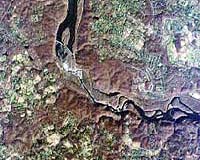 |
Washington DC (SPX) Nov 24, 2010 More than 170 participants gathered this week for the eighth annual National Academies Keck Futures Initiative (NAKFI) conference in Irvine, Calif. This year's topic, imaging science, a field of study that uses physics, chemistry, mathematics, computer science, and cognitive sciences to understand the many factors that influence and enable image capture and analysis. At the conference, top researchers from different fields discussed imaging science and its far-reaching applications - such as astronomy, environmental monitoring, education, and health care - and how it can be used to solve complex problems. Farouk El-Baz, director of the Center for Remote Sensing, Boston University, and this year's conference chair, challenged attendees to push imaging science forward in a nonlinear way. "The promise of imaging science" El-Baz said, "could come from identifying tools and validation methods to develop clinically useful non-invasive imaging biomarkers of psychiatric disease, developing a telescope or starshade to reveal planetary systems around neighboring stars, or developing new ways to detect and classify meaningful changes between two images so that we can determine whether a crop is flourishing or withering, for example, or determine whether a tumor is responding to treatment." He added, "The think-tank format of the NAKFI conference - which focuses on assigning challenges for attendees to solve - will push the limits and move the field of imaging science forward in unexpected ways through the imagination of its participants." During the conference, researchers grouped into teams to explore core issues common to all imaging applications. Each team received a research challenge. Among the challenges were to think of new applications for imaging; improve image processing and recovery; enhance image analysis and understanding; and measure image quality objectively. They also discussed the future of visualization. Graduate students, representatives from public and private funding organizations, government, industry, and the media also partook in the discussions. To encourage further interdisciplinary work, the Futures Initiative announced the availability of $1 million in seed grants - up to $100,000 each -- for new lines of research identified at the conference. Recipients of the competitive grants will be announced in the spring. To help participants overcome differences in terminology used in various fields, experts in those fields presented a series of webcast tutorials on many aspects of imaging science. These tutorials are available online.
Share This Article With Planet Earth
Related Links NAS Earth Observation News - Suppiliers, Technology and Application
 Hyperion Hyperspectral Imager Marks Tenth Anniversary On-Orbit
Hyperion Hyperspectral Imager Marks Tenth Anniversary On-OrbitRedondo Beach CA (SPX) Nov 23, 2010 NASA's first hyperspectral imager in space, built by Northrop Grumman for the Goddard Space Flight Center, is observing its tenth anniversary on-orbit, outliving its design life by 1000 percent. Originally designed for one year of operation with a two year goal, Hyperion continues to deliver highly detailed observations of the Earth's surface, atmosphere and biomass. Built in just 12 month ... read more |
|
| The content herein, unless otherwise known to be public domain, are Copyright 1995-2010 - SpaceDaily. AFP and UPI Wire Stories are copyright Agence France-Presse and United Press International. ESA Portal Reports are copyright European Space Agency. All NASA sourced material is public domain. Additional copyrights may apply in whole or part to other bona fide parties. Advertising does not imply endorsement,agreement or approval of any opinions, statements or information provided by SpaceDaily on any Web page published or hosted by SpaceDaily. Privacy Statement |